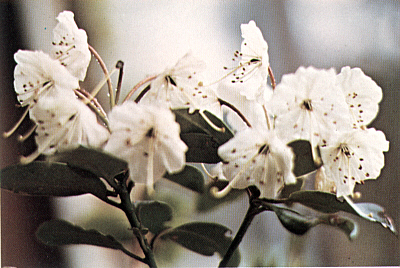An Unusual Intergeneric Cross
Lawrence J. Pierce, Seattle, Washington

|
|
Kalmia latifolia
x
R. williamsianum
Photo by Dr. August Kehr |
Richard A. Jaynes, Associate Geneticist at the Connecticut Experimental Station, published a paper entitled "Kalmias and Their Hybrids" in the July 1971 ARS Bulletin. In this article no mention was made of intergeneric crosses with rhododendrons, only kalmias with their seven other series partners.
Last April 18th, Dr. August Kehr and George Miller were guests of Warren Berg visiting nurseries and gardens in the Tacoma-Seattle area. Fortunately, there was a Study Group picnic and meeting at our home that night which gave Warren an opportunity to bring his guests and gave the Study Group members a chance to know and hear from Dr. Kehr and Mr. Miller.
At that time there was in my garden a plant of
Kalmia latifolia
x
Rhododendron williamsianum
in full bloom. This is believed to be one of the first successful intergeneric crosses between these two genera. It was made by the late Halfdan Lem in the 1950's and he lived to see it bloom. Later he sent a rooted cutting or graft to David Leach. Unfortunately it was lost. To my knowledge, three plants now exist in the Northwest.
At the urging of Dr. Kehr and Warren Berg, the plant was brought indoors to be exhibited and examined by members of the Study Group. It was facetiously labeled "No Suchianum".
Amateurs and near experts viewed and guessed while August Kehr and Warren Berg sat back smiling and unknowing. When the plant's true identity was revealed, many still remained doubting Thomases. Pictures were taken. Stamens were robbed of their meager pollen to go to Beltsville for experimentation.
As the picture indicates, the plant is of medium size like both the parents, has pinkish white, cup-like flowers of all kalmias, but with a larger leaf resembling the male parent,
R. williamsianum.
It's an oddity to be sure, but not freakish. It is happy and hardy in the S. W. area of Seattle on Puget Sound (sometimes referred to as the banana belt by those in the northwest and northeast areas of Seattle subject to early and late frosts.)
Seven cuttings were given to a custom propagator in September to ascertain the ease or difficulty in rooting. Time will tell what growing method is most successful. I find the plant both fascinating and intriguing.
As Dr. Kehr points out, such crosses may be blind alleys and not really useful. But they are of tremendous interest in developing a background of plant relationships and possible evolutionary development.
Editor's Note: A letter from Lawrence Pierce accompanying his article notes that no cuttings are available this year and asks that any such requests be withheld. He hopes that "maybe another year we can satisfy the needs and give information about propagation.